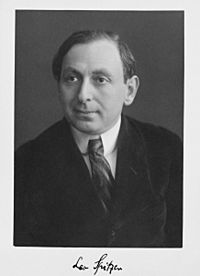Leo Spitzer facts for kids
Quick facts for kids
Leo Spitzer
|
|
|---|---|
 |
|
| Born | 7 February 1887 |
| Died | 16 September 1960 (aged 73) Forte dei Marmi, Italy
|
| Alma mater | Wilhelm Meyer-Lübke |
| Institutions | University of Cologne Istanbul University Johns Hopkins University |
| Notable students | Hans Marchand |
Leo Spitzer (7 February 1887 – 16 September 1960) was an important scholar from Austria. He studied languages and literature, especially Romance languages like French, Spanish, and Italian. He was also a famous literary critic, which means he analyzed and wrote about books and authors. Spitzer was known for focusing on stylistics, which is the study of how writers use language to create their unique style. He is considered one of the founders of comparative literature, a field that compares literature from different countries and cultures.
Contents
Life and Education
Leo Spitzer earned his doctorate degree in 1910. He studied under a well-known scholar named Wilhelm Meyer-Lübke. Spitzer became a professor at the University of Marburg in 1925. Later, in 1930, he taught at the University of Cologne.
Moving from Germany
In 1933, Leo Spitzer had to leave his job. This was because of unfair rules in Nazi Germany at the time, which targeted people of Jewish background. He then moved to Istanbul, Turkey.
Teaching in Istanbul
In Istanbul, Spitzer taught at the Istanbul University for three years. He was the first professor of Latin languages there. He also directed the School of Foreign Languages.
Life in the United States
After his time in Turkey, Spitzer moved to the United States. In 1936, he joined Johns Hopkins University. He stayed there for the rest of his life, continuing his important work in language and literature.
Spitzer's Contributions
Leo Spitzer was famous for his ideas about stylistics. This is the study of how a writer's unique style connects to their personality or way of thinking. He believed that by looking closely at how an author uses words and sentences, you could understand more about the author's mind and their message.
Style and Author's Mind
Spitzer would look for repeated patterns in a writer's language. For example, he studied how Henri Barbusse often used words like "blood" and "wounds" in his writing. Spitzer thought these patterns could show something about the author's deeper thoughts or feelings.
Connecting Style to Ideas
He also tried to link a writer's style to their philosophical ideas. For instance, Spitzer suggested that the repetitive style of Charles Péguy was connected to his Bergsonism philosophy. He also linked the style of Jules Romains to his idea of Unanimism, which focused on group consciousness.
See also
 In Spanish: Leo Spitzer para niños
In Spanish: Leo Spitzer para niños

